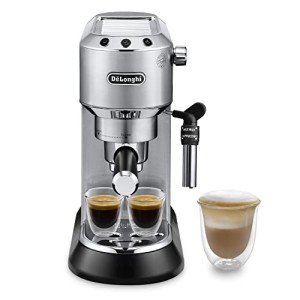5 Qualities People Are Looking For In Every Energy-Efficient Espresso Machines
Energy-Efficient Espresso Machines: A Comprehensive Guide
On the planet of coffee enthusiasts, espresso machines are typically considered necessary appliances for brewing abundant, aromatic coffee. Nevertheless, the energy usage associated with these machines can result in increased energy costs and environmental issues. As customers end up being more eco-conscious, energy-efficient espresso machines have actually emerged as a popular option. This post aims to explore the features, advantages, and alternatives available in energy-efficient espresso machines, assisting coffee lovers make informed options.
What Makes an Espresso Machine Energy-Efficient?
Energy-efficient espresso machines are created to reduce energy usage while maintaining optimal efficiency. Numerous functions contribute to the energy effectiveness of these machines:
Insulation: High-quality insulation helps keep heat, reducing the energy required to keep optimal developing temperatures.
Smart Technology: Many modern machines are equipped with programmable settings that permit users to schedule brewing times and change to standby mode when not in use.
Quick Heat-up Time: Energy-efficient espresso machines typically use sophisticated heating technologies, such as thermoblocks or PID controllers, to heat water quickly.
Low Wattage: Machines that run at lower wattages consume less energy overall, making them more effective.
Automobile Shut-off: Automatic shut-off features guarantee that the machine switches off after a particular duration of lack of exercise, additional lowering energy waste.
Benefits of Energy-Efficient Espresso Machines
Investing in an energy-efficient espresso machine can use a number of benefits:
Cost Savings: Over time, lower energy intake can lead to minimized electricity costs.
Environmental Impact: Using less energy reduces carbon footprints, making these machines a more sustainable option for ecologically conscious consumers.
Improved Performance: Many energy-efficient models also use superior brewing technologies, leading to better-tasting espresso.
Toughness: Typically, energy-efficient machines are developed with high-quality parts, causing higher durability.
Features to Consider
When picking an energy-efficient espresso machine, several features need to be considered:
- Type of Machine: Options consist of manual, semi-automatic, and totally automatic models, each with varying degrees of user control and automation.
- Brew Quality: Look for machines that use high-quality brewing systems to guarantee ideal taste extraction.
- Upkeep: Some machines have self-cleaning functions that can conserve energy and effort in upkeep.
- Capacity: Depending on personal or family size, machine capability can affect energy intake, with bigger machines typically needing more power.
Popular Energy-Efficient Espresso Machines
The market uses a variety of energy-efficient espresso machines dealing with different requirements and choices. Below are some significant designs:
Brand
Model
Secret Features
Energy Consumption
Breville
Barista Express
Integrated grinder, PID temperature control, quick heat-up.
Low
DeLonghi
EC155
Compact size, easy to use, long lasting build.
Moderate
Rancilio
Silvia
Sturdy design, excellent temperature stability, and has a low ecological effect.
Moderate
Gaggia
Classic
Trusted manual operation, resilient brass components, and efficient steaming ability.
Low
Jura
E8
Totally automatic, wise functions, and a detachable brew group for easy cleaning.
Low
Tips for Optimal Energy Efficiency
Aside from choosing an energy-efficient design, customers can adopt numerous practices to maximize energy efficiency:
- Preheat: If your machine has a pre-heating function, use it to make sure that the ideal temperature is reached quickly before brewing.
- Switch off After Use: Always switch off the machine after brewing or utilize machines with auto shut-off functions.
- Routine Maintenance: Keep the machine properly maintained to ensure it operates effectively and effectively.
FAQs About Energy-Efficient Espresso Machines
1. Are energy-efficient espresso machines more pricey?
While the initial financial investment may be higher for energy-efficient models, the long-term cost savings on electrical energy expenses can offset the preliminary expense. Furthermore, numerous energy-efficient machines come with advanced features that enhance the brewing experience.
2. How do I understand if an espresso machine is energy-efficient?
Search for indicators such as Energy Star certification, user reviews, and requirements concerning wattage and heat-up time. Machines with specific features focused on decreasing energy intake are usually created for better performance.
3. Can I use an energy-efficient espresso machine for other coffee styles?
Lots of energy-efficient espresso machines use flexibility, permitting users to brew different coffee styles beyond espresso, such as lattes and coffees, by incorporating steaming capabilities.
4. Do energy-efficient designs compromise quality for effectiveness?
Not always. Many energy-efficient espresso machines are equipped with high-quality developing technology that can improve taste extraction while decreasing energy consumption.
5. What upkeep is needed for energy-efficient espresso machines?
Regular upkeep involves cleaning up the machine, descaling when essential, and regularly examining seals and gaskets to guarantee optimum efficiency and energy efficiency.
Energy-efficient espresso machines represent an ideal mix of efficiency, savings, and ecological obligation. By thinking about Buy Espresso Coffee Machines , advantages, and brands, customers can pick a design that suits their special choices while contributing positively to the environment. As the trend toward sustainable living grows, the appeal of energy-efficient devices, including espresso machines, is most likely to continue its upward trajectory, offering coffee lovers a guilt-free method to enjoy their everyday dose of espresso.
